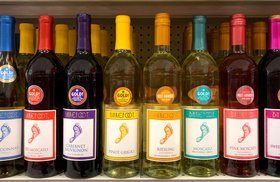Red Wine Nutrition (Calories, Ingredients, Health Benefits)
Curious about the nutrition facts of your glass of red wine?
Wine labels almost never display the wine nutrition information. So, you may not know what your glass of Merlot or Beaujolais Nouveau contains other than the Alcohol By Volume (ABV) percentage or the sulphite content.
So, how do you find out what’s inside your wine glass? How many carbs and calories does your red wine contain? What are the other additives?
In this article, we’ll cover all aspects of red wine nutrition, including the calories and the surprising number of additives and active ingredients, and the health benefits and side effects of drinking red wine.
Further reading
- If you’re interested in Champagne, check out the Luxurious Dom Pérignon
- Want a fun drink to sip at dinner? Try the Delectable Asti Spumante.
Red Wine Nutrition Facts
Apart from the obvious grape juice, sugar, and alcohol, red wine contains a surprising number of constituents, though some may only be in trace amounts.
Let’s take a look at what could be inside your glass of bold red wine!
A. Nutrition information for one glass (5 oz) of red wine
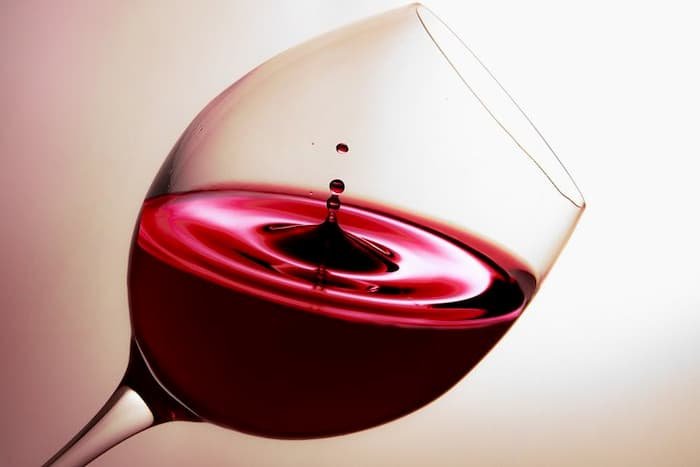
Before getting into the details, here’s a glance at the nutritional value in a 5 oz (147 ml) glass of red and white wine. White wine values are included for comparison.
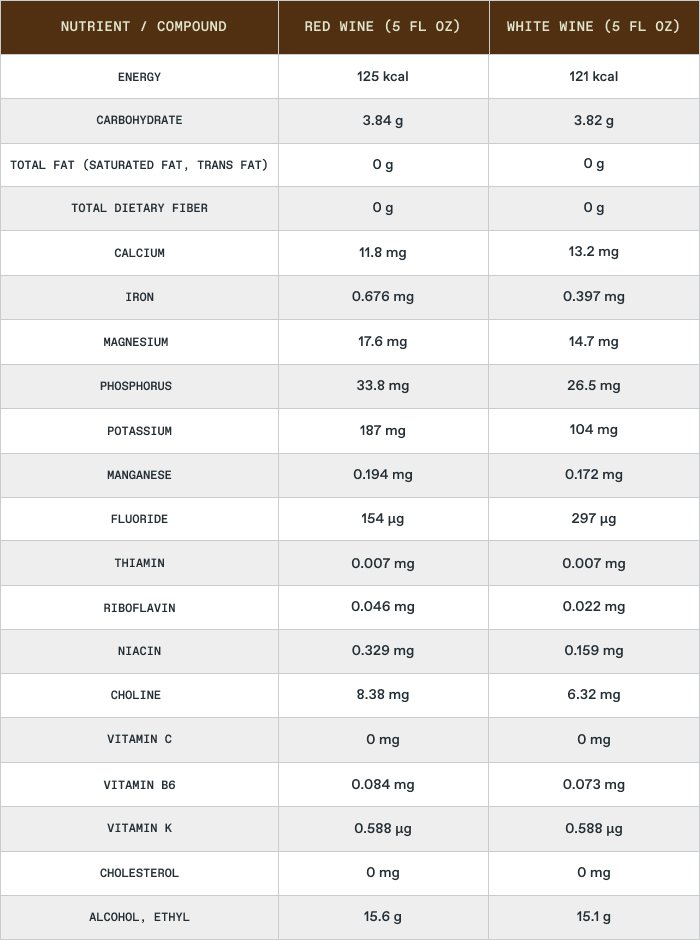
Source: United States Food Administration (USDA)
B. Calories in red wine
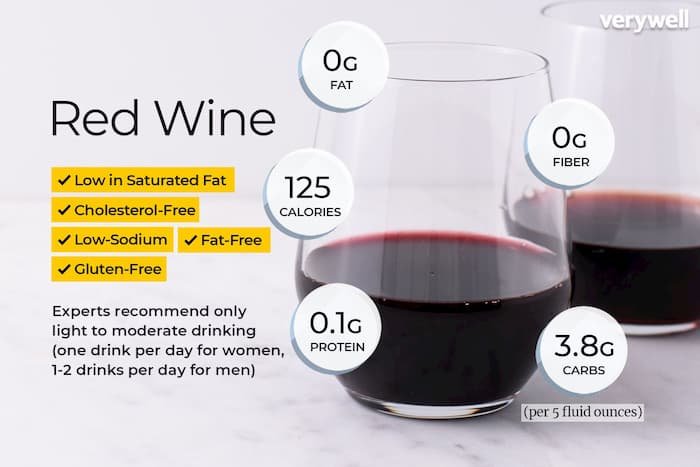
What is the primary source of calories in wine?
The primary source of wine calories is alcohol. 1 gm of alcohol contains 7 calories. Calories from carbohydrate sources like sugar come second. A gram of sugar contains 4 calories, almost half of what’s in alcohol.
If you’re concerned about your calorie intake, keep an eye on the ABV % printed on the wine label. The higher the number, the more calories there are inside the wine.
For example, in a 6 ounce glass (175ml):
- Red wine at 13% ABV contains 160 calories
- White wine at 13% ABV contains 159 calories
- Rose wine
White wine tends to have fewer calories than red wine because of its generally lower alcohol content.
Low calorie wines - do they exist?
Yes, and it doesn’t necessarily have to be something with “low calorie” labeled on the bottle of wine.
Low alcohol, dry red wine like the French Beaujolais, or Bourgogne Rouge with 10.5% ABV can have 105-110 calories in a 5oz pour.
Related articles:
Want to explore the fascinating French wine universe? Check out these articles on
- The best
- The best
A dry white wine, like a Muscadet with 9.5% ABV, will have around 90-95 calories in a 5oz pour.
The key to picking a low calorie wine is making sure that it's a dry wine with low alcohol content. A sweet wine may have low alcohol, but the calorie content will add up from the wine’s residual sugar (RS). Keep those sweet wines like Moscato (with 5.5% ABV and a high RS) away if you’re watching your calorie count!
C. Carbohydrates in red wine

Is red wine high in carbs?
That depends on the wine. Carbohydrates in wine come from the residual sugar. A sweet dessert wine (fortified wine) like Port will have more carbohydrates derived from the sugar content compared to a dry red wine like Cabernet Sauvignon.
To illustrate this, in a 5oz pour:
- Cabernet Sauvignon has about 4 grams of carbohydrate
- Sweet dessert wine has about 20 grams of carbohydrate
As you saw earlier, one gram of carbohydrate contains 4 calories, which is about half of what’s in a gram of alcohol - which is why alcohol contributes more to the calorie count.
And even though alcohol has calories, it isn’t metabolized the same way as carbohydrates. So it doesn’t contribute to the total carbohydrate count in wine.
Can you drink red wine on a low carb diet?
Yes you can. As long as you get a dry wine with minimal residual sugar, you’d be fine even on a low carbohydrate regime like a keto diet.
Now, here comes the surprising ingredients in your glass of wine:
D. Additives in red wine

Winemaking is a rather intricate process, requiring several additives to stabilize its structure and balance out the final flavor. Some of these additives don’t stay in the wine but are removed from the finished product once they’ve done their job.
Of course, there are some winemakers who refuse to use any form of additives - but they’ll be outnumbered by those who use these additives.
What are the additives in red wine?
- Calcium Carbonate: This is a de-acidifier, used to lessen wine acidity, and is sometimes added when grapes have trouble ripening.
- Flavors: Oak has long been used to add flavors, like vanilla, to the wine. Since only a small part of the wine would be in contact with the insides of an oak barrel, winemakers use oak chips, staves, or powders to increase the wine’s oak contact.
- Grape juice concentrate: This concentrate is typically made of Teinturier grapes and is used to boost the color of the wine while adding extra sugar.
- Non-vegan materials: These are fining and clarifying agents commonly used by winemakers, including egg white, gelatin, milk products, and fish bladders. These materials are filtered out before bottling.
- Sugar: The added sugar is not to sweeten the wine, but to boost its alcohol content in a process called “chaptalization.“ This is legal in several regions where grapes have trouble ripening, like Bordeaux.
- Sulfur Dioxide or sulfites: This is used to preserve the grapes and prevent oxidation during winemaking. Most wines can contain around 5–200 mg/L of sulfites, but you won’t see it mentioned on the label unless it exceeds 10 parts per million (ppm, or 10 mg/L). This labeling of sulphites is mandatory in the US and European Union.
- Potassium Sorbate and Potassium Metabisulfite: They are commonly used together during the fermentation process to protect the yeast from spoiling and ward off bacteria.
- Powdered tannins: Tannin occurs naturally in the grape skin and seeds. It makes wine age-worthy and adds complexity to the wine. However, tannins can be challenging to balance through the winemaking process, so powdered tannins are used to adjust the wine’s balance.
- Water: This is used early in the winemaking process to reduce high alcohol levels.
- Yeast: This is the key winemaking ingredient that converts sugar to alcohol. It’s naturally present on the grape skins, though winemakers can use cultured yeast to affect the wine’s flavor.
E. Active ingredients or compounds in red wine

Red wine is known to contain several beneficial polyphenol compounds like anthocyanin, proanthocyanidins, quercetin and resveratrol.
These polyphenols (especially resveratrol) are frequently attributed to the health benefits found in red wine, like preventing heart disease and lower cholesterol levels.
F. Vitamins, minerals and other nutrients in red wine

What other nutrients are there in wine?
Red wine contains a number of minerals and vitamins, thanks to the core ingredient - grapes.
You’ll find Calcium, Iron, Manganese and even Fluoride in red wine, just to name a few.
Most are trace amounts, so don’t rely on your glass of red wine for your daily values!
Is red wine healthier than white wine and rose wine?

Short answer - Yes. Red wine contains more of the antioxidants beneficial to heart health than rose wine or white wine. These antioxidants are present in the skin of the grapes and are leached into the grape juice during the maceration (or skin contact) period. Maceration is what gives red wine its color.
White wine is mostly processed without the skins, so it lacks these antioxidants. Rose wine and orange wine undergo a short maceration period and will have antioxidants too, but less than in red wine.
Now, is red wine good for your health?
Health Benefits of Red Wine

Consider this: you’re allowed to drink red wine in moderation according to the “Mediterranean diet,” which is often recommended for heart health.
The polyphenols in red wine give it these benefits:
Resveratrol:
Is linked to positive cardiovascular health, raising good cholesterol levels and inhibiting cancer cell growth. Resveratrol has anti-inflammatory properties that can help slow neurodegenerative diseases like Alzheimer’s and regulate insulin.
Anthocyanin
and
proanthocyanidins:
These flavonoids can also contribute to antioxidant, cardioprotective, anti-cancer, and anti-aging mechanisms.
Quercetin:
This polyphenol is known for its anti-inflammatory and antiviral properties. It’s also proven to promote healing in arteries and alleviating lung disease.
Red wine also can:
- Lower blood sugar levels (it’s known as a safe option for those with Type 2 diabetes)
- Promote longevity and reduce stress
- Promote liver health
- Reduce depression
Are there vitamins and minerals in red wine?
Yes, red wine contains vitamins and minerals in small amounts. They are:
- Calcium: Strengthens bones and teeth
- Iron: Delivers oxygen throughout your body
- Magnesium: Helps regulate muscle and nerve function
- Phosphorus: Keeps your bones healthy
- Potassium: Regulates blood pressure and heartbeat
- Manganese: Helps active enzymes in metabolism
- Fluoride: Prevents tooth decay
- Thiamin (Vitamin B1) & Niacin (Vitamin B3): Helps release energy from food
- Riboflavin (Vitamin B12): Helps with growth, development, and function of cells
- Vitamin B6: Needed for enzyme reactions in metabolism
- Choline: Helps regulate memory, mood, and muscle function
- Vitamin C: An antioxidant to protect cells from damage caused by free radicals
- Vitamin K: Helps build bones and blood clotting
However, the most important thing is drinking red wine in moderation. None of these health benefits will be worthwhile if you over-consume any alcoholic beverage, including red wine.
How much alcohol consumption is considered moderate?

According to the dietary guidelines on the Centers For Disease Control and Prevention (CDC), it’s one glass of wine for women and two for men per day.
And what is defined as one glass?
That’s a single serving size of 5 oz (148 ml) of 12% ABV wine. Meaning, a large 7 oz pour of Zinfandel in a deceptively tall Bordeaux glass is more than ‘one glass.’
The Side Effects of Drinking Wine

Even with moderate alcohol consumption, you may experience some of these side effects from the alcohol or red wine:
It’s easy to down too many calories.
We often don't pay much attention to calories in what we drink compared to what we eat. But if you’re on a
regime, you do need to watch how many calories are coming from the wine.
Alcohol (not just from wine, but beer and other liquors too) makes you crave salty and fatty food.
So don’t be surprised that you’ll want to reach for the cheesy pizza instead of the crunchy cucumbers in your fridge.
You get a headache after having red wine.
This could be a reaction to the histamines (not the sulfites) in red wine. You could also get a stuffy nose, hives, or digestive issues as well from the histamines. In this case, you may want to switch to white wine, like Pinot Grigio or Chardonnay, instead.
Tummy problems.
The tannins in red wine can lead to digestive issues like stomach aches or diarrhea.
You don’t feel well right away.
If this happens, you could actually be alcohol-intolerant. It’d be best to avoid wine or any other alcohol in this case.
Red wine contains calories and carbohydrates, but why isn’t the nutrition information on the wine label?
Why Aren’t Nutrition Facts Printed on a Wine Label?
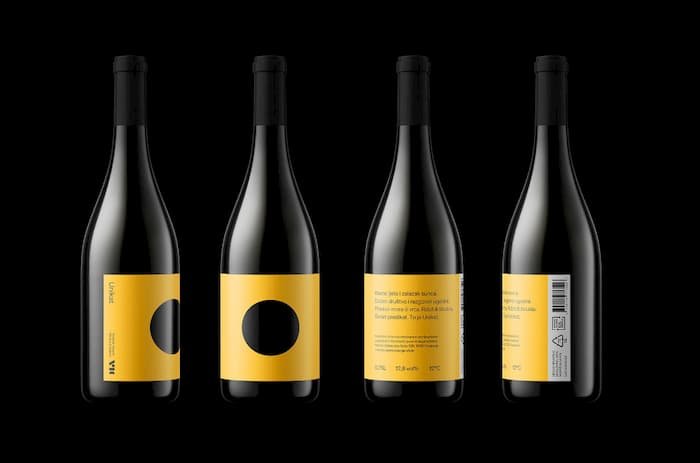
Here’s a couple of reasons why:
Alcohol isn’t regulated by the Food and Drug Administration (FDA) in the US.
Since the Prohibition ended in 1933, alcohol was placed under the Alcohol and Tobacco Tax and Trade Bureau (TTB), which doesn’t require labeling nutrition facts.
Alcohol has special labeling exemptions in some countries.
In the EU, an alcoholic drink above 1.2% ABV is exempt from food labeling. Producers don’t have to declare nutrition content like calories or ingredients, unless it’s sulfites.
Unique winemaking practices.
Wine nutrition labeling could be tough to do. Wine is a unique product, made with variable raw material and can’t be made into a single recipe. The winemaker doesn’t know the final composition and characteristics of the wine when the grape is harvested.
Alcohol in wine isn’t standardized.
When it comes to nutrition, alcohol is the primary source of calories in wine. But there isn’t a standard number for alcohol in wines across the board. For example, you’d find Pinot Noir wines with 11% ABV just as likely with 13% ABV.
As alcohol content is often dependent on grape sweetness, the alcohol in every vintage year could be different, even from the same producer. The same goes for residual sugar as well.
Should wine nutrition details be on wine labels?

It’s easy to ignore the calories from wine, simply because you don’t see the numbers printed on the label. Having the nutritional information available would be good for consumers.
But from a production point of view, mandatory nutrition labeling for wine can increase costs due to changes in oenological practices and laboratory testing. Winemakers would have to test every vintage.
How to Buy Good Quality Red Wines
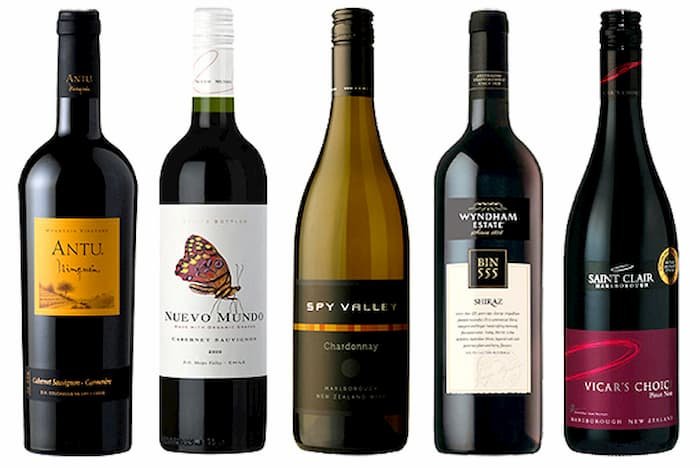
Now, here’s the bigger problem: You’d find red wines in all wine stores, online listings, wine auctions and exchanges - including counterfeit ones!
You would have to do your own research on which wines are the best, compare prices and consider all the extras like shipping, storing, and insurance.
So, is there an easier, more reliable way to buy high-quality red wine?
Luckily, you have world-class wine investment platforms like Vinovest to help you instead.
Vinovest can help you buy (and sell) the finest wines with just a click of the mouse.
Let’s see how that works.
Buy the Best, Authentic Wine Bottles through Vinovest

Vinovest is an Artificial Intelligence (AI)-based online wine investment platform, offering an easy way to buy fine wines, whatever color or style you want, from anywhere in the world.
A professional team of sommeliers and data scientists curates your wine portfolio with proprietary financial models. You won’t ever have to worry about counterfeits either, as Vinovest will check your wines’ authenticity and provenance.
Don’t have a wine cellar?
Don’t worry. Vinovest stores your wines in bonded warehouses, insures them, and delivers your bottles to your doorstep (or to your buyer’s, if you’re selling them.)
Conclusion

Is red wine good for you?
Wine drinkers can rejoice! With moderate consumption, red wine offers some fair benefits as it has more of those potent antioxidants (like resveratrol) than white wine.
As long as you stick to the daily recommended intake, there’s no reason you can’t enjoy a glass on a relaxed evening or for a lively celebration.
While nutrition facts remain mostly unprinted on the bottle, why not ensure that you get the best wines from reputable producers through Vinovest? At least you won’t have to make wild guesses about the quality of the wine swirling in your glass!
Just sign up with Vinovest to build a fine wine bottle collection right away!



